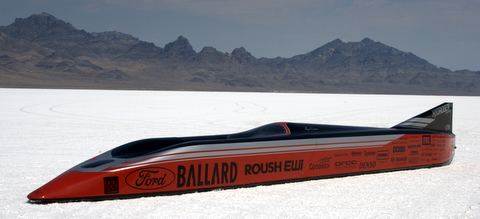 | ||
The Buckeye Bullet is the name of a series of student-built, alternative-fuel race cars created by Ohio State University students led by Dr. Giorgio Rizzoni at the Center for Automotive Research. The cars are designed to run on the world-famous Bonneville Speedway, just outside Wendover, Utah.
Contents
- Buckeye Bullet Team
- Vehicles
- Buckeye Bullet 1
- Buckeye Bullet 2
- Buckeye Bullet 25
- Buckeye Bullet 3
- References
The VBB's have also been called the Venturi "Jamais Contente", referencing the electrically powered first vehicle to top 100 km/h.
Buckeye Bullet Team
The Buckeye Bullet team is composed of students from Ohio State University, primarily through the College of Engineering. The team is provided research space from the Center of Automotive Research at the university.
Vehicles
All Buckeye Bullet vehicles have been electrically powered, with power coming from either batteries or hydrogen fuel cells.
Buckeye Bullet 1
The Buckeye Bullet 1 is a battery electric powered land speed race car, and the first from the Buckeye Bullet team.
The Buckeye Bullet 1 holds the distinction of being the world's fastest electric car with a top recorded speed of 321.834 mph (517.942 km/h). It holds the U.S. electric land speed record at 314.958 mph (508.485 km/h) (Class III/E). It set a BNI (non-FIA) recognized international record at 271.737 mph (437.318 km/h) on October 3, 2004.
Vehicle properties
Buckeye Bullet 2
The Buckeye Bullet 2, or BB2, is the second-generation, student-built, alternative-fuel race car created by the Buckeye Bullet team. It is the first hydrogen fuel cell powered land speed streamliner. It is front-wheel drive. The Buckeye Bullet 2 ran for the first time at Speedweek 2007 and recorded a top speed of 223.334 mph (359.421 km/h) on Oct. 10, 2007. At Speedweek 2008, the BB2 eclipsed its previous mark by reaching 286.476 mph (461.038 km/h), the highest speed ever recorded by a hydrogen/fuel cell vehicle.
On September 25, 2009, the Buckeye Bullet 2 set international land speed records both at 303.025 mph (487.672 km/h) in the flying kilometer and 302.877 mph (487.433 km/h) in the flying mile.
Buckeye Bullet 2.5
The Buckeye Bullet 2.5 is a battery electric version of the Buckeye Bullet 2. The BB2.5 uses the same frame and body as the Buckeye Bullet 2, but replaces the fuel cell power source with batteries. The BB2.5 raced for only one season in 2009. This vehicle was intended to be a testbed for several new technologies in consideration for use on the Buckeye Bullet 3. The most significant technology under consideration was the lithium ion batteries. The batteries used for the BB2.5 were A123 Systems 32113 cylindrical cells. The vehicle was able to set a FIA sanctioned world record at 307.666 mph
(495.140 km/h).
Buckeye Bullet 3
The Buckeye Bullet 3 is a new vehicle that is currently in development, building on the technology of the previous vehicles. It is 4-wheel drive and has a drag coefficient of 0.13. The car has separate powertrains for each axle, with the cockpit in the center. Each powertrain has two electric motors driving a 2-speed transmission, built by Hewland. 1st gear can be used up to 275mph. The target speed for this vehicle is 400 mph. On 22 September 2016, driven by Roger Schroer, it was reported to have clocked 358mph (576kph) during an attempt.
